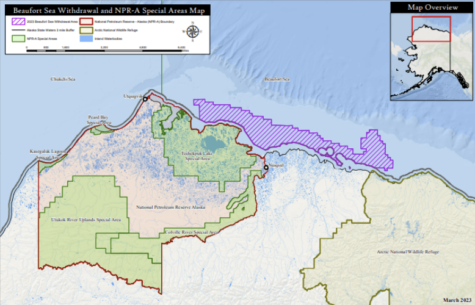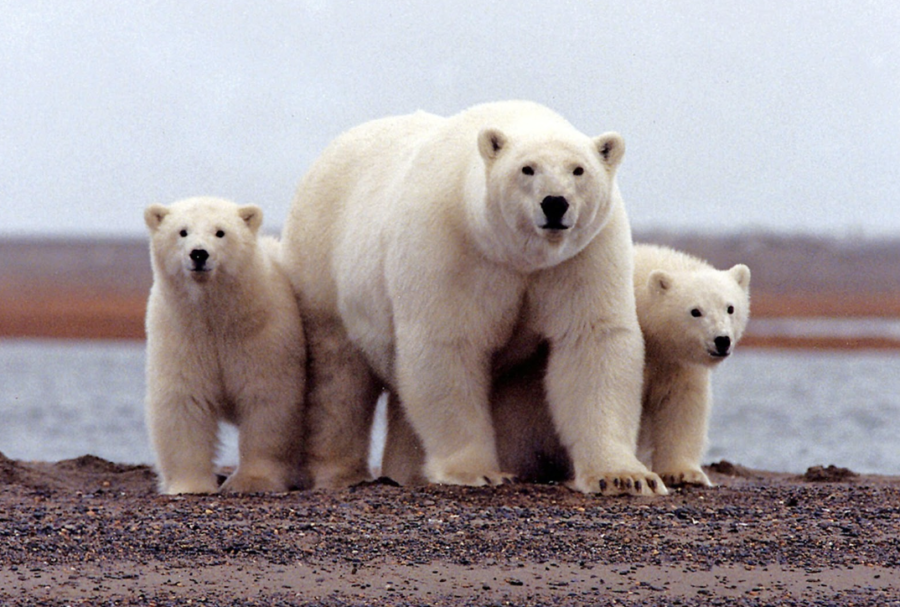The Willow Project: Past, Present, and Future
What is the Willow Project?
Originally announced in 2017, ConocoPhillips’s $7 billion Willow Master Development Plan aims to build miles of road, hundreds of miles of pipelines, airstrips, a new central processing facility, 200 wells, and 3 pads, or areas containing the equipment for drilling, in the National Petroleum Reserve-Alaska (NPR-A). Since the 1990s, this company has acquired the necessary leases to take advantage of Alaskan lands. This is predicted to be sustainable for 30 years, during which it will produce 160,000 barrels of oil per day and release a total of over 250 million metric tons of CO2 into the atmosphere. Through the Biden Administration’s amendments to the plan, ConocoPhillips gave up 68,000 acres of its existing leases in the NPR-A, much of which is in the Teshekpuk Lake Special Area, a wetland area teeming with wildlife. Despite contrasting views from Alaskan Natives, politicians, companies, and environmental activists, the plan was officially approved by Biden on March 13th, 2023, and is set to begin construction as early as this winter. 
What Happened and Is There Support?
The Trump administration originally approved the Willow project towards the end of 2020. However, this was reversed by a federal judge due to its inadequate report on its impact on climate change, non-alignment with laws protecting Teshekpuk Lake, and its potential to harm wildlife. The Bureau of Land Management (BLM) released its review on the project that was declared flawed by the court before the US Interior Secretary David Bernardt approved the record of decisions that allowed ConocoPhillips to continue with up to 3 drill sites and deferred the option of 2 more to a later point. This gave President Biden the choice to approve or veto the Willow project.
Supporters argued that it would add more jobs, increase income to the area, create materials for the US and its allies, and that the number of global emissions would cancel out due to fewer imports. However, this claim made by the Interior Department saying that the US has safer and more environmentally friendly standards than other oil-producing countries was rejected both by outside scientists and by a U.S. federal judge. According to Alaska Republican Senator Dan Sullivan, the Willow project could be “one of the biggest, most important resource development projects in our state’s history.” In addition to Sullivan, Republican Governor Mike Dunleavy, state lawmakers, and the group Voice of the Arctic Iñupiat are all in favor of this plan. U.S. Representative Mary Peltola, a democratic who is part of the Yup’ik indigenous peoples, has also shown her support saying that there is a general consensus of the positive benefits and jobs from the Willow Project and that biologists have determined that this project won’t significantly impact subsistence hunting. Voice of the Arctic Iñupiat is a group that has representatives from across the region that speaks on cultural and economic issues regarding the Arctic Slope. They believe that the Willow project is balanced and will benefit the community through the taxes received. They also say that the U.S. will need oil for at least another 10 years and that the U.S. can either produce or outsource it. The Alaska Native Village Corporation shares similar views, however, ConocoPhillips is one of their sponsors.
Many Alaskan natives are also fighting against this project. The Native Village of Nuiqsut has expressed their concerns regarding the lack of respect, empathy, and action for their community from the BLM along with the BLMs interference with the environment that native people depend on for subsistence. Nuiqsut mayor Rosemary Ahtuangaruak along with many others speaks to the change in lifestyle for locals, and how the caribou and other wildlife would suffer. Environmentalists and many others argue about the long-lasting impacts of speeding up climate change and damaging the nature surrounding the plants. With over 250 million metric tons of carbon dioxide, the Willow project is the biggest contributor to greenhouse gas emissions over any other project. This is equivalent to the amount of carbon dioxide released by 56 million vehicles over the course of a year, or about all of the registered cars in California, Florida, Texas, Illinois, Ohio, Pennsylvania, North Carolina, New York, Georgia, Virginia, and Washington combined. This isn’t taking into account the damage of possible oil spills. Because of the warming climate and the Arctic melting, the area of ConocoPhilip’s facilities would be at risk, forcing them to build chillers to keep the ice stable beneath the buildings.
Many environmentalists are calling out Biden for his promises made at the beginning of his campaign regarding drilling on federal land. When asked about his stance, Biden responded by saying, “No more drilling on federal lands, period. Period, period, period.” While the Biden administration has put less land up for sale than previous administrations, the approval of the Willow project will make it very difficult for the administration’s goal of cutting carbon emissions in half by 2030. Originally, there had been an addition to offset the emissions through planting trees in national forests, however, this proposal wasn’t followed through with and was dropped from the plan. Despite the Biden administration’s promises, the Willow project was approved on March 13.
What is Happening Now?
Just days after the Willow project was approved, Earthjustice decided to sue the BLM, the US Interior Department, the US Fish and Wildlife Services, the National Marine Fisheries Service, and the Department of Commerce. They argue that these departments haven’t fully addressed the issues determined by the court which originally rejected the project, including the inability to fully assess the effects on the climate, the possibility of spills, taking measures to reduce emissions, and more, all violating NEPA, or the National Environmental Policy Act. They say it also breaks the Reserves Act, which protects surface resources among other things, and the ESA, or the Endangered Species Act. Trustees for Alaska, representing the Alaska Wilderness League, Environment America, Northern Alaska Environmental Center, Sierra Club, the Wilderness Society, and Sovereign Iñupiat for a Living Arctic, is also taking legal action against the BLM, Fish and Wildlife Services, and the Department of Interior in order for them to better look at the direct and indirect consequences to the environment and climate.
 On the same day that the Willow project was approved, the Biden administration also released that the Interior Department is planning on passing protection of Special Areas in the NPR-A. Of the 23 million acres on Alaska’s North Slope set aside for future oil projects about a century ago, 13 million will be protected. These Special Areas are home to a significantly large number of grizzly and polar bears, caribou, and migratory birds. An additional 2.8 million acres in the Arctic Ocean nearshore of the NPR-A will also be set as indefinitely off limits to oil drilling, protecting whales, seals, polar bears, and more.
On the same day that the Willow project was approved, the Biden administration also released that the Interior Department is planning on passing protection of Special Areas in the NPR-A. Of the 23 million acres on Alaska’s North Slope set aside for future oil projects about a century ago, 13 million will be protected. These Special Areas are home to a significantly large number of grizzly and polar bears, caribou, and migratory birds. An additional 2.8 million acres in the Arctic Ocean nearshore of the NPR-A will also be set as indefinitely off limits to oil drilling, protecting whales, seals, polar bears, and more.








